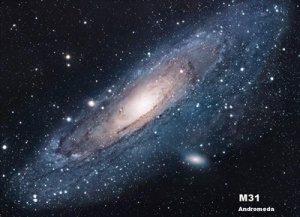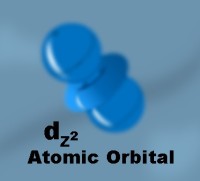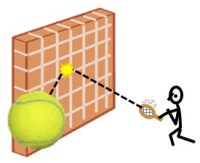Physics and Timepath are compatible views – the past is real; the future – messy probability; the Now separates them.
Well-trained, reputable physicists have published claims that the past is fixed, the future is just like the past but stretches in the other direction, and that the present Now is the point that joins the two. Some even publish that it is possible to travel through time. Are such positions sensible, or, as we believe, are they ideological beliefs supported by wishful thinking?
This is our concluding post in the 4 part series that introduces our Timepath picture of reality. Timepath is not yet a model with new predictions ready for physics testing. It is a pre-hypothesis; a suggestion of how to view world processes to remove the feelings of strangeness generated by (for example) quantum ideas. We begin by discussing the three physics worldviews (paradigms) and compare how they mutually interact. The Timepath description follows, along with a discussion of how the quantum paradigm and Timepath views can work together. Click any image for full resolution
Overview: The Three Paradigms of Physics
This section is a quick summary of the three distinct physics worldviews.
- The Newtonian view of the classically famous 3 laws of motion.
- The Relativistic view with its ‘Special’ description and its cosmological ‘General’ extension.
- The Quantum view that accounts well for the atomic world of the ultra small.
A more complete description for non-technical general audiences can be found in our Physics In 3 Paradigms.pdf.
Newtonian Paradigm (NP)
Isaac Newton’s Laws form the oldest paradigm in physics that that actually works. NP was developed in the mid 1660s. It was released several decades later as the 3 famous laws that students learn in their first classes in physics. NP is deductive and causal in that current interactions cause subsequent motion. NP is also called deterministic. It described and explained activities in ways not possible before.
Nearly every object in the Sidney Harbor view (Fig 1) owes its existence to the success of NP analysis. All the constructed things we use today – bridges, complex buildings, vehicles, lighting, aircraft, etc. show Newton’s success.
They connect the beginnings of NP (accurate descriptions of planetary orbits) to modern explorations of our local environments (underseas, ground-to-atmosphere, and near-Earth space).
NP is our foundation paradigm to understand the world. For this reason it is called Classical Physics.
Relativistic Paradigm (RP)
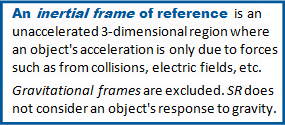 Special Relativity (SR), the initial form of RP, was released in 1905 and extended NP to high velocities, and accelerations in inertial reference frames only. SR is the attempt to find the form of physics ‘laws’ that can be expressed exactly the same way in all inertial frames, independent of any relative velocity (valid laws must be covariant). It assumes that the speed of light has the same numeric value in each reference. These two requirements – covariant laws and invariant light speed – led to startling predictions.
Special Relativity (SR), the initial form of RP, was released in 1905 and extended NP to high velocities, and accelerations in inertial reference frames only. SR is the attempt to find the form of physics ‘laws’ that can be expressed exactly the same way in all inertial frames, independent of any relative velocity (valid laws must be covariant). It assumes that the speed of light has the same numeric value in each reference. These two requirements – covariant laws and invariant light speed – led to startling predictions.
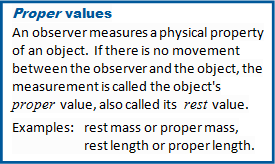 The length of a moving object is always less than its proper length.
The length of a moving object is always less than its proper length.- The duration of a time interval (like the time between successive clock ticks) is always longer than the proper duration.
- If there is in inertial frame where two events are detected to occurring simultaneously, they will not occur simultaneously in any other moving frame.
SR has been strenuously examined through extremely detailed tests. Because it has passed every one of these test, SR now is generally accepted. But to the old NP physicists, it did not “feel like” physics – sure, it made new predictions, but it seemed closer to a philosophical discussion.
General Relativity (GR) is the upgrade to SR and is its natural successor. GR combines the speed of light and simultaneity with gravitational mass to describe the universe as a whole. GR predicted that accumulations of mass will warp straight lines through space and was immediately used to explain the classical anomaly in the precession of Mercury’s orbit as well as the bending of star light around our sun. In its GR form, RP has passed the myriad tests of its predictions.
Physicist John Wheeler (1911-2008) is often quoted to have said
Mass tells space-time how to curve, and
space-time tells mass how to move.
About 20 years ago, the structure and behavior of the Andromeda galaxy (Fig 2) was found to differ a bit from GR calculations, a fact that led to the proposal of dark matter.
So far, no one has observed “dark matter” – does this invalidate GR?
Think about this – neutrinos started as a math tool to let quantum relations work. But. If neutrinos were only a math contrivance, Quantum mechanics would be as acceptable as epicycles or phlogiston. Twenty six years after being proposed, Cowen and Reins (link) detected their very real existence.
Frankly, I am not worried about dark matter – our understanding of galactic dynamics and the universe as a whole is based on the success of GR theory.
Although the SR subset of the RP is accepted by nearly everyone, its GR generalization still makes some physicists squirm, even though it has passed every challenge during the past 100 years. It is in continuous daily use: the GPS location devices use GR calculations in every measurement. Without GR, GPS could not work.
As with its NP predecessor, RP provides accurate deductive predictions from causal relationships. Both are deterministic world views – If you can specify something’s initial state and keep it fully isolated from everything else, you can know with perfect precision what will be happening at any time after the starting point.
Quantum Paradigm (QP)
The physics discipline that underlies the QP is Quantum Mechanics (QM), which describes an atom as a tiny positive central nucleus surrounded by a definitely shaped though diffuse cloud of negative electrons. Since you cannot distinguish between identical electrons, no prediction can be made for any particular one. This means that QP can not provide deterministically predictive descriptions – only most likely ones.
QM‘s “diffuse but definite” cloud is the density of the probability in which the various states that the collection of electrons could exist. The gaseously diffuse probability is called the state’s wave function, and has required decades to understand (assuming we actually do so, now).
Wave function calculations proved precise explanations for what we observe, and accurate predictions about what we should expect. We can picture these as in Fig 3, our artistic conception of the dz2 wave function for the orbital electron distribution in an atom. It shows a distinct though blurry solid against a background of all the general probabilities in the atom’s environment.
QM began as an deterministic orbital model which was merged with SR and had wave stability imposed. It accurately predicted much of the quantum behavior of hydrogen atoms – but not all. To finish the job, to be successful, modern QM was painfully forced to abandon deterministic descriptions in favor of probabilities and statistics.
The 3 paradigms are not mutually consistent
The world views of NP, SR and QM work well with each other. Special relativity is the successful extension of classical Newtonian physics into the realm of ultra-high speeds. Quantum mechanics is considered the successful extension of classical physics into the realm of the ultra-small. SR was merged into modern QM to produce spectacular results, such as the prediction of the existence of anti-matter.
Too bad that QM and GR do not work together at all. The general form of relativity is a hugely successful upgrade to SR, is an extension of NP, and should have merged with QM with truly stunning results. But — no joy in physics-land. Ultimately, it was established that, as currently formulated, GR and QM are incompatible.
The Timepath Viewpoint
LastTechAge has been discussing a view we call the Timepath, describing what really must be the structure of the timeline.
Our diagram of the Timepath view is presented in Fig 4 to help focus the discussion. Click here for the list of our Timepath posts. The flow of an activity is from right to left in our diagram
- The future is seen as the cloud of potential occurrences that accrue linkages to prior events until they coalesce into existence (actualize) at the focus of where things happen: the Now.
- Now is the becoming state when the conditional probabilities, loaded with priors, actualize into events which now act as the priors for the unrealized probabilities.
- Each realized event separates from the becoming Now by an ever increasing interval of elapsed time, slips further back into the general noise of all events that ever existed, and becomes ever-harder to identify. The collection of events self-organize into the 3-dimensional stream of existence called the past.
 There is no firm and concrete future that stretches ahead, even though this is the romantic ideal. Many people, from mystical psychics to physicists, claim differently.
There is no firm and concrete future that stretches ahead, even though this is the romantic ideal. Many people, from mystical psychics to physicists, claim differently.
Two fundamental observations (here and here) support our Timepath view –
- Precognition does not exist, and
- No communication with any future outcome has ever happened.
Any group with knowledge of future outcomes would gain overwhelming evolutionary advantage over its competitors. If future-sight were at all possible, it would have developed sometime during the 700 000+ years we homo saps have been around. Precognitive seers are not present – such capability is not possible.
QM and the wave-particle duality
Wave-Particle Duality One of the foundation ideas from the earliest days of quantum mechanics was that a collection of electron particles (chunks of matter) had to be considered as a system of waves if we were to get the atomic predictions in line with observations.
Early QM (1910-1924) calculated relativistic particle orbits, then imposed wave restrictions on them. Modern QM started in 1925 when Werner Heisenberg used math matrices to get the first correct results.
Very shortly thereafter, Erwin Schroedinger published exactly the same results using waves as the fundamental concept. Schroedinger quickly showed that multidimensional matrices and his “matter waves” were equivalent descriptions. Modern QM is often referred to as wave mechanics.
And yet – even today you hear physicists make muddled statements about what a QM wave means.
If wave functions were actual matter, the mass in an electron would extend to the Andromeda galaxy and beyond. Imagine that you find an object right here. Your discovery must have forced its mass to move instantaneously from vast distances to the local spot here. Since special relativity says that nothing can move faster than light, you could never see anything, ever.
Werner Heisenberg almost had it right. He and Max Born built modern theory by saying that the waves were probability structures with extent, amplitude and phase patterns that controlled the outcome of all interactions. These properties meant that the probability structures had to have 2 components (amplitude and phase) – such things are well described as waves.
But Heisenberg continued on, saying that “nothing” exists below the classical macro-scale level of observation, at the quantum micro-scale there is only the mathematical logic of probability. Modern consensus: he was right about probability waves, but most do not accept his nonexistence postulate.
Our Timepath view focuses on when we do a “measurement.” In QM-speak, when we do a particular math operation, we move from math wave function descriptions of what might happen into the solid, unchanging numerical values that represent what does happen when seen by an outside observer.
But this brings up an important issue. Are there any reality interactions if a human person does not observe them? We ask in Fig 5, did the ball interact with the wall because a person observed it, or because the wall existed and interacted back?
Some physicists say that all is determined by the human observer, and continue on to sound nearly medieval. We take the human-centric meaning away from Physics-Speak.
The QM observable is the object’s property after its wave function has collapsed into physicality, become an “entity” in the world. That is, when the object is able to interact with other such realized entities. Prior to the collapse all we have are probability waves; when the wave collapse occurs, it is interacting with something. Unless the interaction continues, the object is again best described as probability.
- Physics: the wave function of the system collapses to a real value that is measurable.
- Timepath: probabilities of what could happen converge (actualize) to tangible reality at the point we call Now.
Compare the 2 bullets – I am convinced that Heisenberg’s nonexistence postulate was almost right, but instead of nonexistence below a certain 3 dimensional size, the quantum description refers to how probabilities collapse into measurable effects as the future tense becomes the present Now. QM describes actions before and during the point where probabilities (wave functions) actualize into interactions (mathematically collapse into real values) that can effect the rest of the universe (become measurable).
 Physics is founded in Philosophy Physics is a study in philosophical epistemology in that it is the quest to find the rules that underlie all interactions in our universe. Let us give these terms in philosophy meanings in physics.
Physics is founded in Philosophy Physics is a study in philosophical epistemology in that it is the quest to find the rules that underlie all interactions in our universe. Let us give these terms in philosophy meanings in physics.
A being parameter – something that is fully described by the measurement done in a single moment.
Distance is a being parameter. At exactly 4:00 PM on 1803-August-15 the ink pot was 30 cm away from Napoleon Bonaparte’s right hand. With a perfect historical record, you could measure such precise distances between any objects anywhere. Location has unchanging existence, it is a being property. Being parameters belong to the past.
A becoming parameter – something that requires more than one measurement moment to understand. Something with no true existence at the moment of Now.
 Speed is a becoming parameter. 100 km/hr means a speed requiring the duration of 1 hour to travel 100 kilometers. The length of time (duration) requires two successive measurements.
Speed is a becoming parameter. 100 km/hr means a speed requiring the duration of 1 hour to travel 100 kilometers. The length of time (duration) requires two successive measurements.
If you could precisely locate a flying plane at an exactly time, you can not identify motion. High speed photographs of a transport airplanes show them as frozen in the air with apparently stationary propellers. You cannot tell the speed of the airplane nor of its propellers from an instantaneous image – you need duration to measure speed.
Becoming requires more than one instant to understand and therefore must be a changing property.
 A physical wave is a becoming object. Its properties cannot be meaningfully measured by a single point observation. About 5 separate measurements are required to give a unique value to most parameters of a water wave, for example. If the wave has a 30 cm wavelength, maybe it sound like a being property; but you cannot characterize it without those 5 points along its path. Waves are becoming objects — and are what QM is all about.
A physical wave is a becoming object. Its properties cannot be meaningfully measured by a single point observation. About 5 separate measurements are required to give a unique value to most parameters of a water wave, for example. If the wave has a 30 cm wavelength, maybe it sound like a being property; but you cannot characterize it without those 5 points along its path. Waves are becoming objects — and are what QM is all about.
The Past is solid and unchanging, a being concept. Now is the moment of dynamic change, a becoming concept; by our definition, though, Now cannot be measured because one of the measurements must be in the past. The Future is potential with no realized existence – neither being nor becoming.
The Heisenberg Uncertainty Principle (HUP)
 Popular description of the HUP. You may never know the exact value for the position or speed of a quantum object because if you do you must lose all understanding of the other. Physics-Speak sometimes refers to this as strange, or even spooky … meaning ghost-like or haunted.
Popular description of the HUP. You may never know the exact value for the position or speed of a quantum object because if you do you must lose all understanding of the other. Physics-Speak sometimes refers to this as strange, or even spooky … meaning ghost-like or haunted.
Physics description. Modern QM theory was forced to use probability distributions for its parameters and the HUP emerged directly from very early applications of statistics to quantum parameters.
QM has the physics property Action buried at its very deepest heart. Action is the value you get when you multiply a being parameter (such as distance) by its related becoming partner (such as speed … actually momentum). The paired parameters are called action conjugate pairs. The conjugate pairs are chosen so that the resulting action value has units of angular momentum. It sounds strange, but is deeply relevant.
The QM HUP result is –
- Multiply the statistical uncertainties in the values for both parameters of any action conjugate pair (length TIMES momentum or energy TIMES duration).
- The product is always greater than a very tiny value, h, which also has the units of action and is called Planck’s constant.
Physics description of the HUP result: neither parameter in an action conjugate can have an exactly precise value (zero uncertainty).
HUP is described as a purely quantum effect, but Heisenberg proposed it using a classical physics analysis of how a microscope works. Our macro-sized classical world also obeys the HUP – as we described earlier from imaging a moving airplane.
With human macro-scale perception, Planck’s constant is indistinguishable from zero. Events at our world macro-scale follow uncertainty rules without our realizing it.
The HUP connects being and becoming parameters and are a result of predicting across the boundary of Now.
How does QM define the formation of Now?
Quantum processes must guide much more than the outcomes of isolated and well controlled laboratory experiments. QM must…
- apply to the start of the universe,
- be the engine behind its continuation,
- surely control its end.
But, how can the complex interactions that actually happen “in the wild” work in the regime of the quantum paradigm? There are a number of people working hard to understand this.
Background in probability
Classical probability ideas are described in beginning statistics courses, but are rarely taught as stand-alone classes. Even in their simplest form they are hard to make part of your world understanding because, although they are straightforward, probability considerations feel different from most math ideas.
 The issue becomes much more complex when you start adding the fact that related events have already happened. Attach a flock of preconditions to a possible outcome, and you will have made it difficult to decide what will happen.
The issue becomes much more complex when you start adding the fact that related events have already happened. Attach a flock of preconditions to a possible outcome, and you will have made it difficult to decide what will happen.
Consider the situation in our side box. The first question is straightforward simple probability.
The second question requires conditional probability. It becomes ever more challenging to resolve conditional probability if as you continue adding more conditions. The solution formalism is called Bayesian statistics; see our last Timepath post. Simple events that actualize (happen) Now may be the consequence of the cloud of probability that has been burdened by hundreds of preconditions.
Events such as a war battle may be difficult to predict, but QM has a even harder task because probabilities arise from waves which have both amplitude and phase.
QM and reality
The convergence of probabilities into an actualized event is not an especially original concept. For example, Walter Grand’s excellent Entropy And The Time Evolution Of Macroscopic Systems (OUP, 2008) has an excellent non-math discussion of time and Bayesian Statistics at the start of his Chapter 3.
I am aware of at least 2 groups who are grappling with how our reality can grow out of quantum decoherence (the collapse of states of conditional probability into the observed actuality).
Wojciech Zurek has been working since before 1991 to demonstrate the existence of quantum pointer states – quantum states which reappear unchanged in every realization (measurement) of the same quantum system. Zurek calls the process of being measured and surviving intact each time Quantum Darwinism. Our reference is to his 2014 Physics Today article where he shows that survival of the pointer states comes from taking into account of the state of the environment. His details are intended for physics graduate students, but his beginning and ending plain language discussion is understandable and fascinating.
Chris Fuchs has been developing the Quantum Bayesian (QBism) approach for at least 15 years. Fuchs and his team use quantum information theory with Bayesian conditional probability to describe how probability wave functions decohere (collapse, actualize) into observations. Again, his articles are for professional physicists, but his abstracts, introductory paragraphs, and final conclusions should be understandable by most people. David Mermin has several enlightening comments on QBism in Physics Today.
Please make a note: Neither of these are generally/universally accepted approaches to quantum understanding. They are fiercely criticized, and strongly defended. What they both do, however, is to charge head-first into the the battle of understanding how how classical reality forms. This post has not been reviewed by Drs. Zurek, Fuchs, or Mermin.
Endings
Timepath refers to the viewpoint that things that become realized events all form in the instantaneous Now. Things past are unchangeable, things in the future are all potential probabilities that are heavily encumbered by prior events to generate complex conditional probability. QM is the physics study of how probabilities in isolated systems collapse into the measurable expectation values of emerging reality.
The physics community is undergoing strong technical arguments over these ideas and other related issues. There is not yet a workable answer but researchers have separate conclusions of how things ought to work. They seem to ‘fall in love’ with their own ideas because they cling to them as to a beloved. Result: physics is splitting into subgroups is almost the way most world religions have split. The fierce disagreements are not over lab-tested data, but over unproven, untested pictures. We discussed this denominalization of the science of physics here.
Many questions arising from our discussion may have been discussed at a non-technical level in our Physics In 3 Paradigms.pdf. Check it out. We will put updates to the Timepath ideas in our .pdf listings.
……………………………….
Charles J. Armentrout, Ann Arbor
2015 Dec 20
Listed under General… a post in the thread General > Time Path
Have a comment? Click on the title of this post, go to bottom, let us know.
Related posts: Click the INDEX menu under the Banner picture


